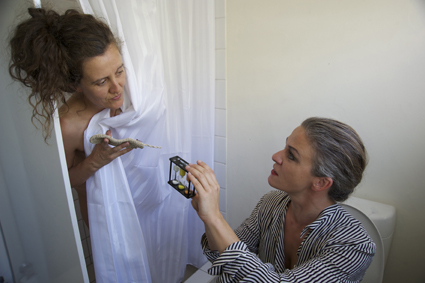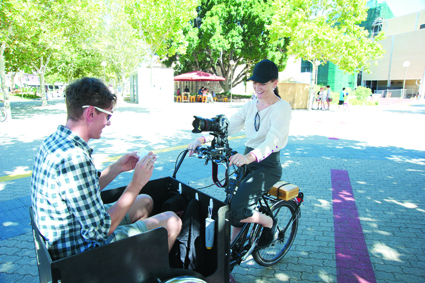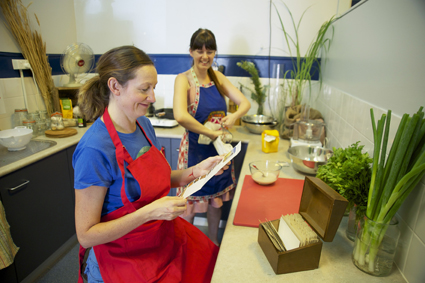the ups & downs of one-on-one
laetitia wilson: proximity festival of one-on-one art, 2012 fringe world

How To Have A 3 Minute Shower (2012) Jen Jamieson, Proximity Micro Festival of One-on-One Art
photo Ashley de Prazer
How To Have A 3 Minute Shower (2012) Jen Jamieson, Proximity Micro Festival of One-on-One Art
THE UP CLOSE AND PERSONAL FORMAT OF THE ONE-ON-ONE PERFORMANCE IS FAMILIAR FROM THE SEX SHOPS IN THE STREETS OF NORTHBRIDGE, BUT WHEN TAKEN INTO THE CONTEXT OF LIVE ART, BECOMES SOMETHING ENTIRELY DIFFERENT. IT COMES WITH ITS OWN DEGREES OF INTIMACY, AWKWARDNESS, PLAYFULNESS AND, INDEED, PRIVATE DANCERS AND STRIP SHOWS.
Proximity, staged as part of Fringe World at the Blue Room theatre in Perth, is Australia’s first live art micro-festival comprising12 one-on-one performances, each lasting about 12 minutes, featuring twelve artists with a unique take on the concept of proximity. Artists drawn from dance, theatre, live and visual arts presented works curated by James Berlyn, produced by Sarah Rowbottam and provoked by Kelli McCluskey (PVI Collective).
The idea of proximity can be interpreted and communicated in numerous ways. The pieces ranged from offering convivial, occasionally banal, encounters to abrupt challenges to personal inhibitions. The entirety of the sensorium became involved. Like a puzzle, the program began with a map, detailing the location and order of the pieces and, like clockwork, announcements were made to indicate their beginning or end. In the face of potential confusion the event was managed and timed to precision. If it were a game it would be full of mysterious choices, challenges hiding behind closed doors, hairy monsters, quirky stories and shadowy portals into alternate worlds. Once in the swing of it, I eagerly followed the path from one encounter to the next, as a solo adventurer facing the unexpected with a wee bit of trepidation—did I really want my own private hoofer? Did I really want to fondle a beard?
My personalised map began with Ush and Them by Nikki Jones, a conversational, wandering piece acknowledging the oft-neglected role of the usher. It was undeniably tongue-in-cheek with Jones taking a toilet break and leading me straight to the lighting room in lieu of any show. The majority of the performances were anchored to a similar kind of conversational interactivity resulting in social, relational, inter-subjective and often instructive experiences. Participants were simultaneously drawn into the world of the performers and invited to reflect on their own circumstances. The success of each performance was largely reliant on the individual personalities, communicative and performative abilities of the artists, which made for a spectrum of experiences, from raw to refined.

Sarah Nelson, Mobile Moments, Series 2 (2012), Micro Festival of One-on-One Art
photo Ashley de Prazer
Sarah Nelson, Mobile Moments, Series 2 (2012), Micro Festival of One-on-One Art
An existential element came to the fore in two of the strongest pieces, Sarah Nelson’s Mobile Moments and James Berlyn’s Sweetlife. Although very different, these two pieces invited consideration of personal views and morality respectively. Berlyn’s beautifully crafted game placed the audience member in a staged context: delightfully pink, strategically lit, with the sound of ticking timers and the temptation of lolly bags in the background. At one point the participant’s body became a game piece, pulse and iris movements were measured to determine whether or not a sweet life/just desserts were deserved. Moral qualms gave way to thoughtful musings in Mobile Moments, a gentle roving journey through the cultural centre. As passengers on a trike, participants were filmed responding to specific questions around personal likes, dislikes and life decisions. This piece was both subtle in its articulation and incredibly resolved in extending to an aesthetically engaging after-life in a series of video portraits screened in the cultural centre in the weeks to follow.
More practical concerns were addressed by Renae Coles in The Union. Situated in the Blue Room offices, Coles put on a bureaucratic face and saturated the participant with officious banter, providing a unionist official type service for those with a miniscule axe to grind. In a characteristic twist toward the ridiculous, Coles morphed these mini-complaints into a punk song, made all the more ludicrous by the thrashing head movements and belted lyrics emanating from the neatly dressed performer. Practicality was also at the heart of Jennifer Jamison’s How to Have a Three Minute Shower, an instructive realisation of the local water corporation’s billboard advertising. Jamison talked participants through her shower routine while taking one herself and then inviting us to freshen up too, all the while discussing the intricacies of showering and emphasising environmental conscientiousness by accumulating water in buckets.
This kind of close interaction and focused conversation did not dominate every encounter; some performers invited no response, as in the whimsical bedtime story told by Russya Conner. Others embraced silence, with intent or incidentally. Janette McGinty used it to effect in Hydrosis, a theatrical narrative in a tight filing cabinet where silence was harnessed to heighten tension at the moment of confrontation with the physical proximity of McGinty’s armpits. Silence was less an intentional tool in Helen Russo’s Fragmentation 1.2. Participants were guided to shine a torch on Russo’s semi-naked body as she writhed from entrapment within an old school desk. The only sound was the shuffling of her body; the only light was from the torch.
The relation between dancer and solo viewer can so easily become voyeuristic and silence can generate a heightened sense of awkwardness, correlating with the experience of finding yourself alone with a stranger. This was thankfully bypassed in Claudia Alessi’s Your Private Hoofer which allowed the participant to select music and costume: a minor gesture toward interactive exchange which relieved the prospective unease of a personalised dance.
Similarly, in Flush, a game of strip poker with Janet Carter, it was easy to become absorbed by game-play, not to mention diversionary tactics—it was remarkable how little time it took to find oneself facing the removal of underwear. Fortunately Carter was self-admittedly an unskilled player. Even the dirty talk in Glory Hole Beard, by Jackson Eaton, launched into the realm of the absurd rather than the awkward. In this well-rehearsed piece, a very large beard, too much beard in fact, proudly thrust itself forth toward the participant through a hole in a toilet door. Did I want to touch it? No! But I did, compelled less by choice than obligation.

Sarah Rowbottom & participant, Slow Food Sunday (2012), Proximity Micro Festival of One-on-One Art
photo Ashley de Prazer
Sarah Rowbottom & participant, Slow Food Sunday (2012), Proximity Micro Festival of One-on-One Art
Finally, with a nod in the direction of relational art of the 1990s, Sarah Rowbottam’s Slowfood Sunday provided the chance to get back to the basics of the everyday in its mindfulness about consuming local produce. Thankfully there were more than two people to enjoy the meal. When sitting at the dinner table sharing wholesome food and talk of the day, one key point became apparent; there is something very special about being an audience of one, but there is also something poignantly lonely about it. In all the investigations of proximity, however physically close and conversationally intimate, the audience/performer divide remained. Against this background the dinner was a salvaging moment and potent reminder that gratifying proximity comes in such simple moments of everyday communal ritual.
2012 Fringe World: Proximity Micro Festival of One-on-One Art, curators James Berlyn, Sarah Rowbottam, provocateur Kelli McCluskey, presented by Blue Room & Proximity Festival; Blue Room Theatre, Perth, Jan 29, Feb 5, Feb 12, Feb 19
RealTime issue #108 April-May 2012 pg. 6






